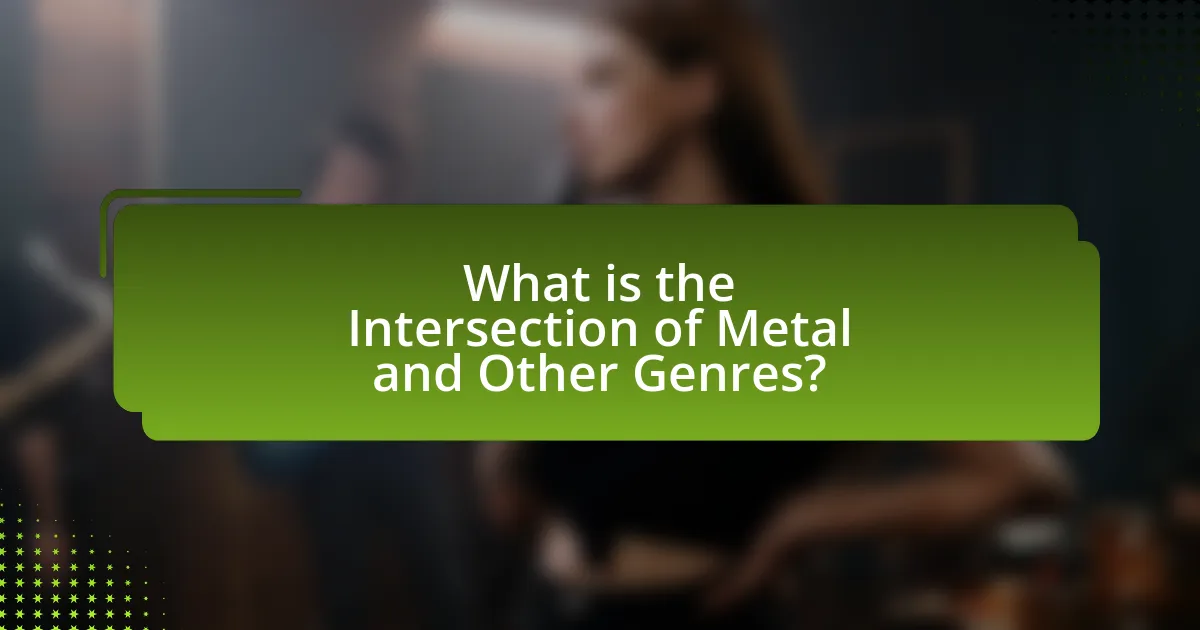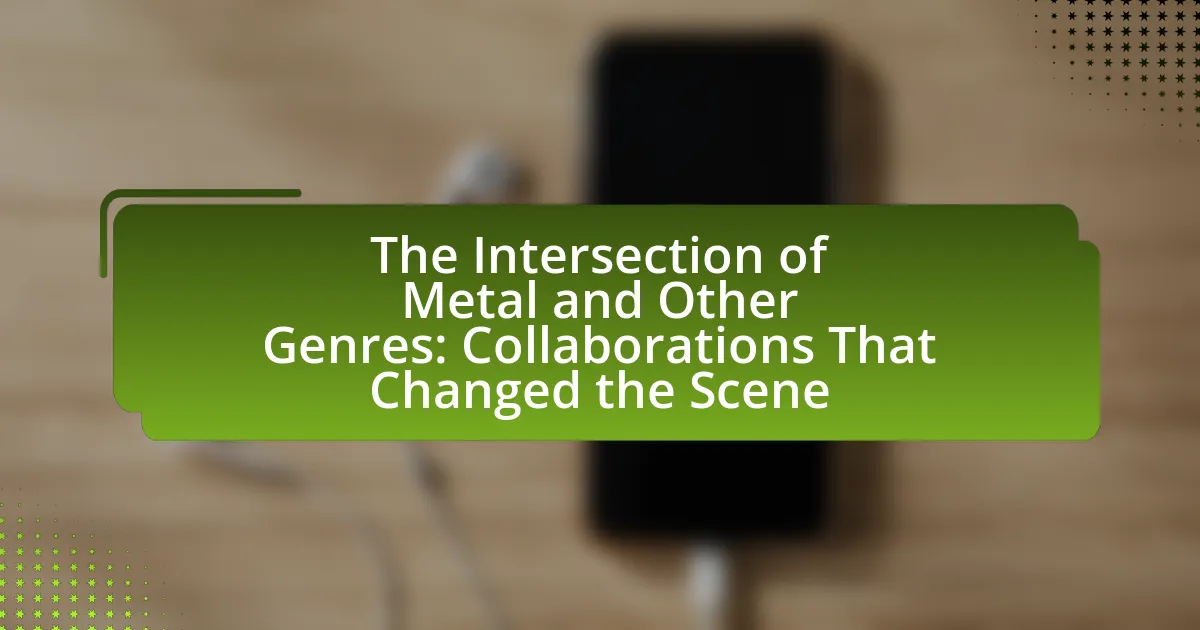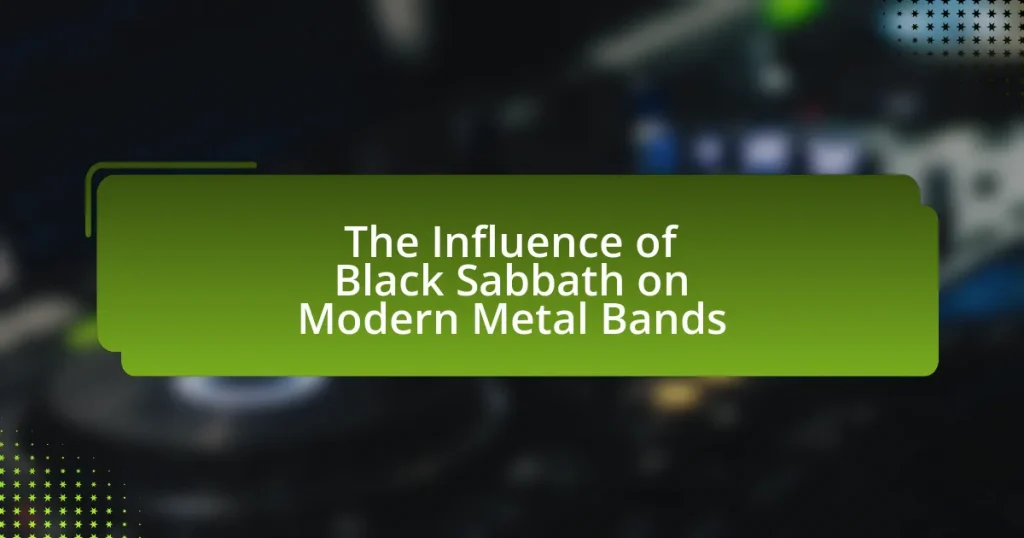The article examines the intersection of metal music with various genres, highlighting how this fusion has led to the creation of innovative subgenres and collaborations. It discusses the evolution of metal’s genre-blending since the late 20th century, influenced by historical events and technological advancements. Notable collaborations, such as those between Metallica and the San Francisco Symphony, as well as Linkin Park and Jay-Z, are analyzed for their impact on the music industry and audience demographics. The article also addresses the challenges and best practices for successful genre collaborations, emphasizing the importance of communication and experimentation in creating unique musical experiences.

What is the Intersection of Metal and Other Genres?
The intersection of metal and other genres occurs when metal music incorporates elements from genres such as rock, punk, jazz, classical, and electronic music. This blending creates subgenres like symphonic metal, which combines orchestral arrangements with heavy metal instrumentation, exemplified by bands like Nightwish and Epica. Additionally, collaborations between metal artists and musicians from other genres, such as the partnership between Metallica and the San Francisco Symphony for the “S&M” album, showcase how these intersections can lead to innovative musical experiences. These collaborations not only expand the sonic palette of metal but also attract diverse audiences, demonstrating the genre’s versatility and adaptability.
How has the fusion of metal with other genres evolved over time?
The fusion of metal with other genres has evolved significantly since the late 20th century, leading to diverse subgenres and collaborations. Initially, in the 1980s, metal began incorporating elements from punk, resulting in thrash metal, exemplified by bands like Metallica and Slayer. The 1990s saw the emergence of nu-metal, blending metal with hip-hop and alternative rock, as demonstrated by bands like Linkin Park and Korn.
In the 2000s, metalcore emerged, combining metal with hardcore punk, featuring bands such as Killswitch Engage and As I Lay Dying. The fusion continued to expand into genres like symphonic metal, where orchestral elements were integrated, as seen in the works of Nightwish and Epica. More recently, collaborations with electronic music have gained popularity, with artists like Bring Me the Horizon experimenting with electronic elements in their sound.
This evolution reflects a broader trend of genre-blending in music, driven by technological advancements and changing listener preferences, showcasing metal’s adaptability and influence across various musical landscapes.
What historical events influenced genre collaborations in metal?
The historical events that influenced genre collaborations in metal include the rise of punk rock in the 1970s, the emergence of hip-hop in the 1980s, and the globalization of music in the 1990s. The punk rock movement introduced a raw, aggressive sound that metal bands began to incorporate, leading to the development of subgenres like thrash metal. The crossover between metal and hip-hop became prominent in the late 1980s, exemplified by collaborations such as Run-D.M.C. with Aerosmith on “Walk This Way,” which showcased the blending of these two distinct genres. Additionally, the globalization of music in the 1990s facilitated collaborations across various styles, as artists sought to reach wider audiences and experiment with diverse influences, resulting in innovative fusions like nu-metal, which combined elements of metal, hip-hop, and alternative rock.
How have technological advancements impacted these collaborations?
Technological advancements have significantly enhanced collaborations in the music industry, particularly in the intersection of metal and other genres. These advancements, such as digital audio workstations, high-quality recording software, and online collaboration platforms, have enabled artists from diverse backgrounds to work together seamlessly, regardless of geographical barriers. For instance, the rise of platforms like SoundCloud and Bandcamp has allowed metal musicians to collaborate with artists from genres like hip-hop and electronic music, leading to innovative cross-genre projects. Additionally, advancements in social media have facilitated real-time communication and promotion, allowing collaborations to reach wider audiences quickly. This has resulted in successful projects like the collaboration between metal band Trivium and rapper Lil’ Wayne, showcasing how technology has transformed the landscape of musical partnerships.
Why are collaborations between metal and other genres significant?
Collaborations between metal and other genres are significant because they expand the musical landscape, allowing for innovation and the blending of diverse influences. These collaborations often result in unique sounds that attract a broader audience, as seen in the fusion of metal with genres like hip-hop, orchestral music, and electronic music. For instance, the collaboration between metal band Linkin Park and rapper Jay-Z on the “Collision Course” EP showcased how merging styles can create commercially successful and critically acclaimed music, leading to increased visibility for both artists. Such partnerships not only enhance creativity but also challenge genre boundaries, fostering a more inclusive music culture.
What cultural shifts have resulted from these musical intersections?
Cultural shifts resulting from the intersections of metal with other genres include the broadening of musical boundaries and the emergence of hybrid subgenres. Collaborations between metal and genres like hip-hop, pop, and classical have led to increased acceptance of diverse musical influences within the metal community. For instance, the collaboration between metal band Linkin Park and rapper Jay-Z on the “Collision Course” EP in 2004 exemplified this blending, attracting a wider audience and demonstrating that metal can coexist with mainstream music. Additionally, the fusion of metal with electronic music, as seen in the works of bands like Enter Shikari, has contributed to a more inclusive music scene that embraces experimentation and innovation. These shifts reflect a cultural evolution where genre barriers are increasingly blurred, fostering a more collaborative and diverse musical landscape.
How do these collaborations challenge traditional genre boundaries?
Collaborations between metal and other genres challenge traditional genre boundaries by blending distinct musical elements, creating innovative sounds that defy classification. For instance, the collaboration between metal bands and hip-hop artists, such as the partnership between Linkin Park and Jay-Z on “Collision Course,” merges aggressive guitar riffs with rap verses, resulting in a hybrid genre that appeals to diverse audiences. This fusion not only expands the listener base but also encourages artists to experiment with their musical styles, leading to the emergence of subgenres like nu-metal and metalcore. Such collaborations demonstrate that genre lines are increasingly fluid, allowing for greater artistic expression and redefining what constitutes metal music.

What are Some Notable Collaborations in Metal?
Notable collaborations in metal include the partnership between Metallica and Lou Reed on the album “Lulu,” which fused metal with avant-garde rock, showcasing a unique blend of styles. Another significant collaboration is the project “Down” featuring members of Pantera and Crowbar, which combined sludge metal with southern rock influences, resulting in a distinctive sound. Additionally, the collaboration between Slayer and Ice-T on the track “Disorder” exemplifies the crossover between metal and hip-hop, further expanding the genre’s reach. These collaborations illustrate how metal artists have successfully merged their sound with other genres, creating innovative music that resonates with diverse audiences.
Which artists have successfully blended metal with other genres?
Artists such as Metallica, Linkin Park, and Sepultura have successfully blended metal with other genres. Metallica incorporated elements of classical music in their album “S&M,” showcasing orchestral arrangements alongside heavy metal. Linkin Park fused nu-metal with hip-hop and electronic music, evident in their groundbreaking album “Hybrid Theory,” which achieved multi-platinum status. Sepultura combined metal with Brazilian tribal music in their album “Roots,” which received critical acclaim and expanded the genre’s boundaries. These artists exemplify the successful integration of metal with diverse musical styles, influencing the evolution of the genre.
What are the defining characteristics of these collaborations?
The defining characteristics of collaborations between metal and other genres include genre blending, innovative soundscapes, and cross-genre appeal. These collaborations often merge distinct musical elements, such as heavy guitar riffs from metal with melodic components from pop or orchestral arrangements, creating a unique auditory experience. For instance, the collaboration between metal band Metallica and symphonic orchestra in “S&M” showcases how orchestral elements can enhance the intensity of metal music. Additionally, these partnerships frequently attract diverse audiences, expanding the reach of both genres and fostering a richer musical dialogue. The successful integration of contrasting styles exemplifies the creative potential inherent in such collaborations, as seen in projects like Linkin Park’s fusion of nu-metal with hip-hop influences.
How have these collaborations been received by fans and critics?
Collaborations between metal artists and musicians from other genres have generally been well-received by both fans and critics, often praised for their innovative blending of styles. For instance, the collaboration between metal band Metallica and symphonic orchestra in “S&M” received critical acclaim, with a 1999 review from Rolling Stone highlighting its successful fusion of heavy metal and classical music. Similarly, the partnership between Slipknot and rapper Tech N9ne in “With the Stone” was noted for its unique sound, earning positive feedback from fans who appreciated the genre crossover. These examples illustrate that such collaborations are often celebrated for pushing musical boundaries and creating fresh, engaging experiences.
What impact have these collaborations had on the music industry?
Collaborations between metal and other genres have significantly expanded the music industry’s audience and creative boundaries. These partnerships have led to the fusion of diverse musical styles, resulting in innovative sounds that attract fans from various genres. For instance, the collaboration between metal bands and hip-hop artists has introduced metal to younger audiences, exemplified by the success of tracks like “Walk This Way” by Aerosmith and Run-D.M.C., which revitalized interest in both genres. Additionally, such collaborations have increased streaming numbers and chart performance, as seen with the rise of genre-blending tracks on platforms like Spotify, where cross-genre collaborations often dominate playlists. This trend has not only diversified the sound of contemporary music but also reshaped marketing strategies within the industry, encouraging labels to promote genre-defying artists and collaborations.
How have they influenced the careers of the artists involved?
Collaborations between metal artists and those from other genres have significantly influenced the careers of the artists involved by expanding their musical reach and audience. For instance, when metal bands collaborate with hip-hop artists, they often gain exposure to a new demographic, as seen with the collaboration between Linkin Park and Jay-Z on “Collision Course,” which introduced both artists to each other’s fan bases and resulted in increased sales and streaming numbers. Additionally, these collaborations often lead to critical acclaim, as they showcase versatility and innovation, exemplified by the success of Metallica’s collaboration with the San Francisco Symphony on “S&M,” which not only revitalized their image but also earned them a Grammy Award. Such partnerships have proven to be pivotal in shaping the careers of artists by enhancing their artistic credibility and commercial viability.
What trends have emerged from successful genre fusions?
Successful genre fusions have led to the emergence of several key trends, including the blending of musical elements, cross-genre collaborations, and the expansion of audience demographics. For instance, the fusion of metal with genres like hip-hop and electronic music has resulted in innovative sounds that attract diverse listeners, as seen in collaborations like Linkin Park’s work with Jay-Z. Additionally, the incorporation of orchestral elements into metal, exemplified by bands like Nightwish, has created a symphonic metal subgenre that appeals to classical music fans. These trends demonstrate how successful genre fusions not only enhance musical creativity but also broaden the reach and influence of metal music across various cultural landscapes.

How Can Artists Effectively Collaborate Across Genres?
Artists can effectively collaborate across genres by establishing clear communication, respecting each other’s creative processes, and blending their unique styles to create innovative works. Clear communication ensures that all parties understand their roles and contributions, which is crucial for a successful collaboration. Respecting each other’s creative processes allows artists to maintain their individuality while working together, fostering an environment where diverse ideas can flourish. Blending unique styles can lead to groundbreaking music, as seen in collaborations like Linkin Park and Jay-Z’s “Collision Course,” which combined rock and hip-hop elements, resulting in a commercially successful and critically acclaimed project. This approach not only enhances creativity but also broadens the audience reach for all artists involved.
What strategies can musicians use to create successful genre fusions?
Musicians can create successful genre fusions by blending distinct musical elements while maintaining a cohesive sound. This involves identifying complementary genres, experimenting with instrumentation, and incorporating diverse rhythms and melodies. For instance, the collaboration between metal and hip-hop artists, such as the track “Judgment Night” featuring Biohazard and Onyx, showcases how contrasting styles can enhance each other, resulting in a unique auditory experience. Additionally, artists like Linkin Park have successfully fused rock and electronic elements, appealing to a broader audience and demonstrating the effectiveness of genre blending.
How important is communication in collaborative projects?
Communication is crucial in collaborative projects as it directly influences the effectiveness and success of teamwork. Effective communication ensures that all team members are aligned on goals, expectations, and responsibilities, which is essential for achieving desired outcomes. Research indicates that teams with strong communication practices are 25% more productive than those with poor communication, highlighting its impact on performance. Furthermore, clear communication helps to mitigate misunderstandings and conflicts, fostering a more cohesive working environment. In the context of collaborative projects, especially in the intersection of metal and other genres, communication facilitates the blending of diverse ideas and styles, ultimately leading to innovative and successful musical collaborations.
What role does experimentation play in genre blending?
Experimentation is crucial in genre blending as it allows artists to explore and combine diverse musical elements, creating innovative sounds that challenge traditional genre boundaries. This process fosters creativity and encourages collaboration, leading to unique musical expressions that can resonate with broader audiences. For instance, the fusion of metal with genres like jazz or hip-hop has resulted in groundbreaking works, such as the collaboration between metal band Rage Against the Machine and hip-hop artist Cypress Hill, which exemplifies how experimentation can yield fresh and influential music.
What are the common challenges faced in genre collaborations?
Common challenges faced in genre collaborations include differing artistic visions, communication barriers, and audience expectations. Artists from different genres often have unique styles and creative processes, which can lead to conflicts in direction and execution. For instance, a metal musician collaborating with a pop artist may struggle to reconcile heavy instrumentation with lighter melodies. Additionally, communication issues can arise due to varying terminologies and approaches to music production, complicating the collaboration process. Audience expectations also pose a challenge, as fans may resist changes to their preferred genre, leading to potential backlash against the collaboration. These factors can hinder the successful integration of diverse musical elements, making genre collaborations complex and often difficult to navigate.
How can artists overcome creative differences?
Artists can overcome creative differences by establishing open communication and mutual respect. Effective dialogue allows artists to express their ideas and concerns, fostering an environment where diverse perspectives can be integrated. For instance, successful collaborations often involve compromise, where each artist contributes their unique style while aligning on a shared vision. Research indicates that collaborative projects, such as those seen in the fusion of metal with genres like jazz or hip-hop, thrive when artists actively listen to one another and seek common ground, leading to innovative outcomes that resonate with broader audiences.
What logistical issues should be considered during collaborations?
Logistical issues that should be considered during collaborations include scheduling conflicts, resource allocation, and communication barriers. Scheduling conflicts arise when collaborators have differing availability, which can delay project timelines. Resource allocation involves ensuring that all parties have access to necessary tools and materials, which is critical for maintaining productivity. Communication barriers can lead to misunderstandings and misalignment of goals, making it essential to establish clear channels and protocols for interaction. These factors are crucial for successful collaboration, as evidenced by numerous case studies in the music industry where poor logistics have resulted in failed projects or suboptimal outcomes.
What are the best practices for successful genre collaborations?
Successful genre collaborations require clear communication, mutual respect, and a shared vision among artists. Establishing open dialogue ensures that all parties understand each other’s artistic goals and boundaries, which fosters a collaborative environment. Mutual respect for each genre’s unique elements allows artists to blend styles effectively, creating innovative sounds that resonate with diverse audiences. A shared vision helps align the creative process, ensuring that the collaboration remains focused and cohesive. Historical examples, such as the collaboration between Metallica and Jay-Z on “Numb/Encore,” demonstrate how these practices can lead to groundbreaking results that appeal to fans across genres.


